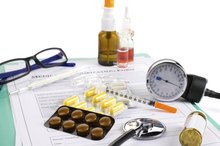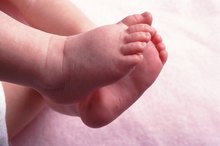3 Types of Jaundice
Jaundice is a term used to describe an increase in the amount of bilirubin in the body, which results in the whites of the eye, skin and body fluids all turning yellow. When all is functioning properly, bilirubin, a byproduct of old red blood cells, is processed by the liver, excreted in bile and ultimately transformed into waste. When the liver cannot handle the volume of retiring red blood cells, yellow pigment will build up in the body. Doctors usually categorize jaundice into three different types; each results in yellowing pigmentation but for different reasons.
If you are experiencing serious medical symptoms, seek emergency treatment immediately.
Physiologic Jaundice
Physiologic jaundice is common in newborns whose livers have not fully developed the ability to process bilirubin. This period of jaundice usually resolves itself within two to three days, but the infant is carefully monitored during his hospital stay to ensure the liver is functioning properly prior to being discharged. According Medline Plus website, bilirubin tends to accumulate more easily in the first days of a newborn's life, before babies are able to produce proper stools or bowel movements.
A type of exaggerated physiologic jaundice is referred to as "breastfeeding jaundice," which usually appears during the first week of a newborn's life. According to Medline Plus, breastfeeding jaundice is believed to be a result of inadequate breast milk intake, leading to dehydration or low caloric intake. Breastfeeding jaundice usually peaks during an infant's second or third week of life, and providing the infant is ingesting sufficient calories usually resolves itself without causing any medical problems. Breastfeeding jaundice should be monitored by a pediatrician.
- Physiologic jaundice is common in newborns whose livers have not fully developed the ability to process bilirubin.
- According Medline Plus website, bilirubin tends to accumulate more easily in the first days of a newborn's life, before babies are able to produce proper stools or bowel movements.
Pathologic Jaundice
Difference Between Physiological & Pathological Jaundice
Learn More
Pathologic jaundice can occur in children and adults and is diagnosed when jaundice presents a health risk 1. In infants, pathologic jaundice can occur when what starts as physiologic jaundice becomes exacerbated by dehydration or a premature or complicated birth.
Gilbert Syndrome
Gilbert’s syndrome is a harmless hereditary condition that results in mild jaundice. During times of illness or stress, people with Gilbert's syndrome will experience low levels of some bilirubin-processing enzymes in their livers, according to LabTestsOnline.com. Once diagnosed, Gilbert's syndrome does not require further medical treatment.
Related Articles
References
- Peoples-health.com: Jaundice
- Bilirubin Blood Test. US National Library of Medicine. 2019.
- Jaundice. US National Library of Medicine. March 2019.
- Chen HL, Wu SH, Hsu SH, Liou BY, Chen HL, Chang MH. Jaundice revisited: recent advances in the diagnosis and treatment of inherited cholestatic liver diseases. J Biomed Sci. 2018;25(1):75. doi:10.1186/s12929-018-0475-8
- Liver function test. US National Library of Medicine. September 2019.
- Hepatitis Panel. US National Library of Medicine. October 2019.
- Ziessman HA. Hepatobiliary scintigraphy in 2014. J Nucl Med Technol. 2014;42(4):249-59. doi:10.2967/jnumed.113.131490
- Gamersddin M, Abdalgaffar R, Yousef M.The role of ultrasound in diagnosis of obstructive Jaundice causes in Sudanese population. IOSR Journal of Nursing and Health Science. 2013;1(4):25-28. doi:10.9790/1959-0142528
- Herrine SK. Jaundice in Adults. Merck Manual Consumer Version. May 2018.
- Hemolytic Anemia. National Institutes of Health.
- Gallstones. Cleveland Clinic. October 2019.
- Bhutani VK. Filtered sunlight noninferior to conventional phototherapy. J Pediatr. 2016;170:341-2. doi:10.1016/j.jpeds.2015.12.054
- Siddiqui AA. Primary Sclerosing Cholangitis. Merck Manuals Consumer Version. November 2018.
Writer Bio
Based in Charlotte, N.C., Virginia Franco has more than 15 years experience freelance writing. Her work has appeared in various print and online publications, including the education magazine "My School Rocks" and Work.com. Franco has a master's degree in social work with an emphasis in health care from the University of Maryland and a journalism degree from the University of Richmond.








